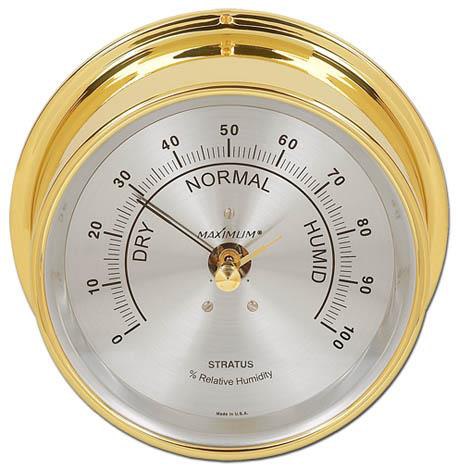How Humidity Instruments Work

What is a Humidity Instrument?
A humidity instrument is used to measure how much moisture is in the air because humidity is something you can’t always see, but can usually feel. While most things are measured in scientific units like, kilograms, meters, or seconds, humidity is slightly different and measured in two very different ways.
How to Use a Humidity Instrument
One possible measurement is called the specific humidity, which is the mass of water vapor present in a mass of air (including the water), written in units such as grams per kilogram. There’s a very similar measurement called the mixing ratio, which is the mass of water vapor in a mass of dry air, also written in units such as grams per kilogram.
A much more common measurement is called relative humidity, which is the amount of water vapor in the air compared to the maximum amount there could possibly be at that temperature, written as a percentage only. On a very wet day, the relative humidity is likely to be 90–100 percent; on a dry day, with a dry wind blowing, and little or no chance of rain, it’s more likely to be 60–75 percent. When meteorologists talk about the humidity percentage, they are referring to relative humidity.
Why Does Knowing Humidity Matter?
We’ve all heard the difference between a hot summer in the American Southwest and the American Southeast is that the Southwest experiences a “dry heat” while the Southeast experiences more humidity. The reason a humid 90-degree day can feel hotter than a 100-degree dry day is due to the human body’s way of regulating temperature. Our bodies cool themselves through the evaporation of our sweat, so on a day with 95% relative humidity your sweat won’t evaporate because the air is already nearly saturated with moisture, so your body won’t be able to cool, making it feel hotter than a dry day. This is why a weather report shows the “feels like” temperature on a humid day to be higher than the air temperature. So if you just have an outdoor thermometer at home you may not be getting the full picture of how hot it will really feel to you. For example, if the air temperature is 90-degrees, the “feels like” temperature would be 94.6 degrees at 50% relative humidity, and a whopping 126.6 degrees at 95% relative humidity. That’s why heat stroke and heat exhaustion is more common in humid climates than in dry ones.
Humidity also causes certain materials to change shape, most notably wood. During a humid summer you may notice the doors in your house don’t open or close as easily, or that your stairs creak more. That happens because wood absorbs the moisture in the air around it and begins to swell. So if your front door is stuck in the middle of summer, it could be simply because it has swelled up on a particularly hot and humid day, and it will go back to functioning properly when the humidity level drops.
How Does a Hygrometer Work?
A hygrometer is an essential instrument in meteorological science. It has numerous commercial uses, but the primary purpose of the device is to measure the amount of water vapor (humidity) in the air.
The main use of the instrument is to provide the amount of moisture in the air and compares that number to the maximum amount of moisture that the air, confined space, or soil can potentially contain. Just like other instruments used for measuring humidity, hygrometers work by relying on other quantities or measurements of temperature, mass, and pressure among others as these things absorb moisture.
In the case of an electronic humidity instrument, they can measure the capacitance or resistance of an air sample and calculate the humidity from that.
In the case of a capacitive hygrometer, there are two metal plates with air in between them. The more water there is in the air, the more it affects the plates’ capacitance. By measuring how much of this charge can be stored, the humidity can be measured. Capacitive hygrometers are created for applications where price, fragility, or space is a concern, so they risk the accuracy of reading moisture for the affordability of the device.
What Are the Three Different Types of Hygrometers?
There are 3 different types of hygrometers: Resistive, capacitive, and thermal conductivity hygrometers.
Resistive Hygrometer
The conducting film of the resistive hygrometer is made of lithium chloride and carbon. The conducting film is placed between the metal electrodes. The resistance of the conducting film varies with the change in the value of humidity present in the surrounding air.
The moisture absorbed by the lithium chloride will depend on the relative humidity. If the relative humidity is high, the lithium chloride will absorb more moisture, and its resistance decreases. The change in the value of resistance is measured by applying the alternating current to the bridge. The obstructions that occur in the flows of current show the value of resistance or the value of relative humidity.
Capacitive Hygrometer
The change in capacitance of the capacitor shows the surrounding humidity. The capacitive hygrometer gives a very accurate result, and is made by placing the hygroscopic material between the metal electrodes.
The hygroscopic material can quickly absorb the water because the capacitance of the capacitor decreases. The electronic circuit then measures the change in capacitance.
Thermal Conductivity Hygrometer
Thermal conductivity humidity sensors are used to measure absolute humidity. They do this by calculating the difference in the thermal conductivity of dry air versus humid air. Two NTC thermistors are suspended by thin wires with the sensor.
One of the thermistors sits in a chamber that is exposed to the air through a series of ventilation holes. The second thermistor is placed in a different chamber within the sensor that is hermetically sealed in dry nitrogen. An electrical bridge circuit passes current to the thermistors which begin to self-heat.
Since one of the thermistors is exposed to humidity from the air, it will have different conductivity. A measurement of the difference in resistance of the two thermistors can be made which will be directly proportional to the humidity level.
How to Use a Humidity Instrument at Home
To fully understand how to use a humidity instrument or hygrometer, it helps to know when and where you can use it. User-adjustable and easy-to-use, our Maximum humidity instruments can be easily installed right in your home. We’ve built these instruments with durability in mind, so we know you can measure humidity for years to come. The Stratus, our relative humidity instrument provides an accurate, reliable, reading of outdoor relative humidity over a scale of 0-100%. A needle at the center of the instrument allows you to observe changes in conditions.
 Or maybe you would prefer the ComfortMinder, which combines indoor humidity and indoor temperature in one instrument. You can fine-tune comfort anywhere in your home with the help of the ComfortMinder. Suitable for outside use in protected locations. No external wires or sensors are needed.
Or maybe you would prefer the ComfortMinder, which combines indoor humidity and indoor temperature in one instrument. You can fine-tune comfort anywhere in your home with the help of the ComfortMinder. Suitable for outside use in protected locations. No external wires or sensors are needed.
Final Thoughts
Humidity can have a drastic affect on the “feels like” temperature, so knowing the humidity levels is a good way to know how to dress for the weather before leaving your house. Check out all of Maximum’s humidity instruments at https://www.maximum-inc.com/weather-instruments/humidity

